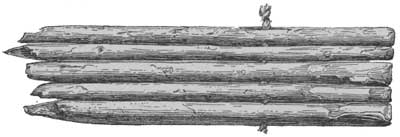MINOR ANTIQUITIES
(continued)
BASKETRY

FIG. 14. Fragment of basket.
|
Not a single entire basket was found, although a few
fragments of baskets made of woven rushes or osiers were obtained (fig.
14). It would appear, however, from a fine basket figured by
Nordenskiöld, which he ascribes to Spruce-tree House and from other
known specimens, figured and unfigured, that the Mesa Verde people were
skillful basket makers. None of the fragments obtained by the author,
and the same holds true regarding the basket figured by
Nordenskiöld, are decorated.
WOODEN OBJECTS
Few objects made of wood were obtained at Spruce-tree
House, but those which were found are well made and reveal the existence
of interesting aboriginal customs. Wooden objects closely resembling
some of these were used until a few years ago by the Hopi and other
Pueblo tribes.
STICKS TIED TOGETHER
Among the wooden objects found are many perforated
sticks tied together by strings. This specimen (fig. 15) is not
complete, but enough remains to show that it is not unlike the covering
in which the Hopi bride rolls her wedding blankets. From the place where
the object was found, it appears that the dead were wrapped in coverings
of this kind. Although the specimen is much damaged, it is not difficult
to make out from the remaining fragment the mode of construction of the
object.

FIG. 15. Sticks tied together.
|
SLABS
Nordenskiöld figures a wooden object of
rectangular shape, slightly concave on one side and more or less worn on
the edges. Two similar wooden slabs (fig. 16) were found at Spruce-tree
House. The objects occasioned much speculation, as their meaning is
unknown. It has been suggested they are cradle-boards, a conjecture
which, in view of the fact that similar specimens are sometimes found in
child burials, is plausible. In this interpretation the holes which
occur on the sides may have served for attachment of blankets or hoops.
These boards, it may be said, are small even for the most diminutive
Indian baby.

FIG. 16. Wooden slab.
|
Another suggestion not without merit is that these
boards are priest's badges and were once carried in the hands suspended
by strings tied to the holes in their edges.

FIG. 17. Spindle and whorl.
|
Still another theory identifies them as parts of head
dresses called tablets, worn in what the Pueblos call a tablita dance.
The upright portions of some of the Hopi altars have
similar wooden slabs painted with symbolic figures and tied together.
Altars having slabs of the same description are used in ceremonials of
certain Tewan clans living in New Mexico.
SPINDLES
There were found at Spruce-tree House a complete
spindle with stick and whorl (fig. 17), and a whorl without the spindle,
both of which are practically identical in type with the spinning
apparatus of the Hopi Indians. When in use this spindle was made to
revolve by rubbing it on the thigh with one hand, while the other held
the unspun cotton, the fiber being wound on one end of the spindle. This
implement affords still another indication that the arts of the people
of Spruce were similar to those still practised by the Pueblos.

FIG. 18. Ceremonial sticks.
|
PLANTING-STICKS
A few sticks which resemble those used by the Hopi as
dibbles were collected at Spruce-tree House. These measure several feet
in length; they are flat at one end, while the opposite end is pointed
and rubbed down to a sharp edge. Some of these implements were slightly
bent at one extremity.
MISCELLANEOUS OBJECTS
Among various wooden objects found at Spruce-tree
House may be mentioned sticks resembling prayer offerings and others
which may have been employed in ceremonials (fig. 18.)
A fragment of a primitive fire-stick (fig. 19) was
obtained from the northern refuse-heap and near it were straight sticks
that undoubtedly served as fire-drills. There were one or two needles
(fig. 20), made of hard wood, suggesting weaving or some similar
process. A fragment of an arrow was unearthed in the debris of the
northern refuse-heap.

FIG. 19. Primitive fire-stick.
|

FIG. 20. Wooden needle.
|


